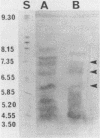Abstract
Fibrobacter succinogenes produces an α-glucuronidase which cleaves 4-O-methyl-α-d-glucuronic acid from birch wood 4-O-methyl-α-d-glucuronoxylan. Very low levels of α-glucuronidase activity were detected in extracellular enzyme preparations of F. succinogenes on birch wood xylan substrate. The release of 4-O-methyl-α-d-glucuronic acid was enhanced when the birch wood xylan substrate was predigested by either a purified Schizophyllum commune xylanase or a cloned F. succinogenes S85 xylanase. These data suggest that the α-glucuronidase is unable to cleave 4-O-methyl-α-d-glucuronic acid from intact xylan but can act on unique low-molecular-weight glucuronoxylan fragments created by the cloned F. succinogenes xylanase. The cloned xylanase presumably must account for a small proportion of the indigenous xylanase activity of F. succinogenes cultures, since this xylanase source does not support high glucuronidase activity. The α-glucuronidase and associated hemicellulolytic enzymes exhibited higher activities in culture fluid from cells grown on ball-milled barley straw than in that of cellulose-grown cells. The profile of xylanases separated by isoelectric focusing (zymogram) of culture filtrate from cells grown on barley straw was more complex than that of culture filtrates from cells grown on cellulose. These data demonstrate that F. succinogenes produces an α-glucuronidase with an exacting substrate specificity which enables extensive cleavage of glucuronic acid residues from xylan as a consequence of synergistic xylanase action.
Full text
PDF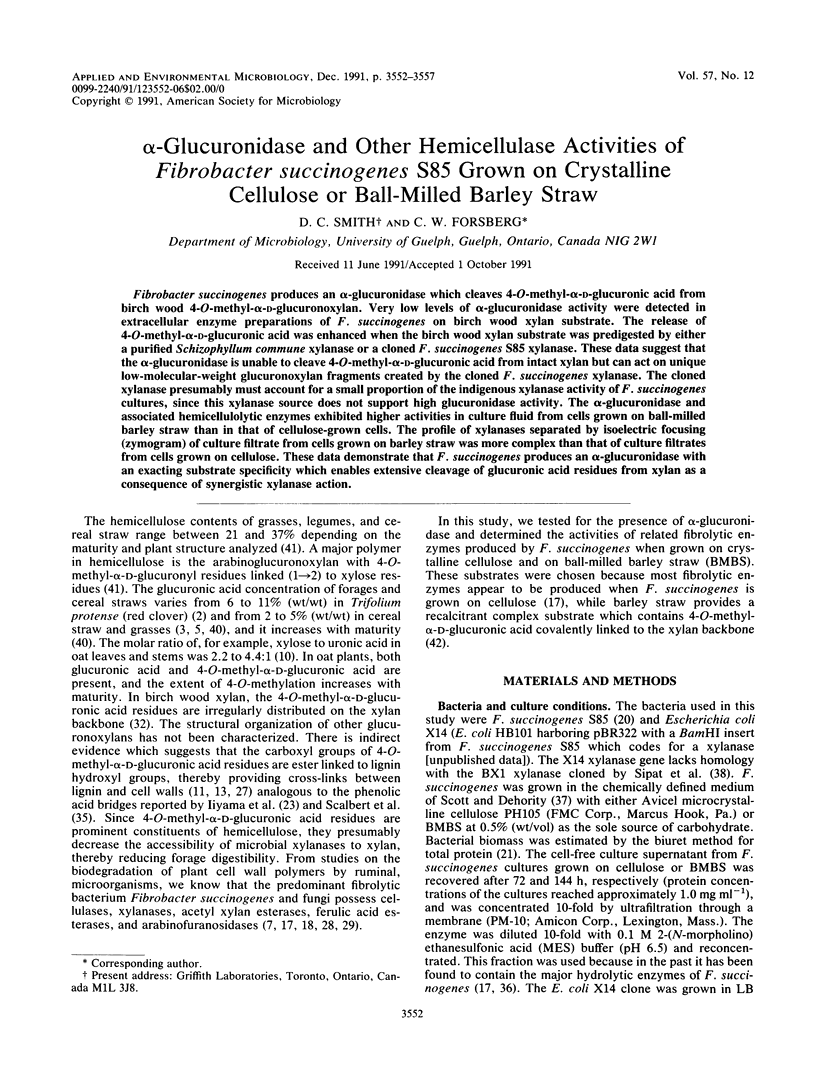
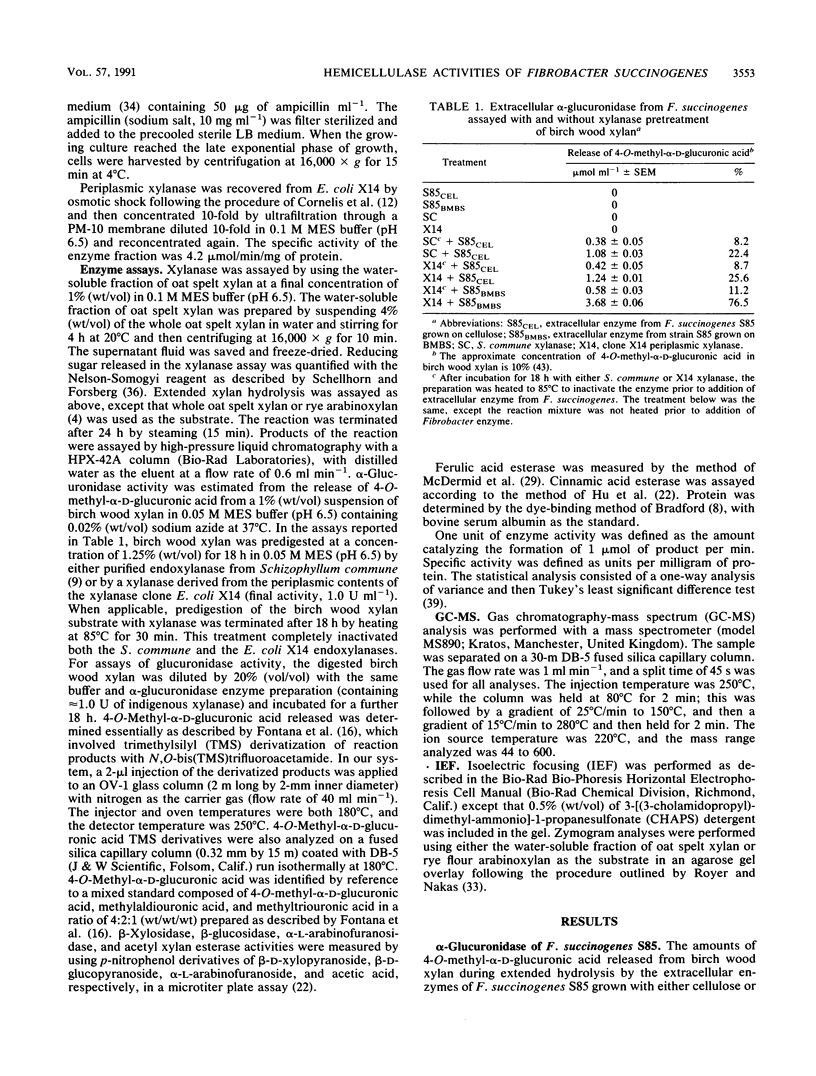
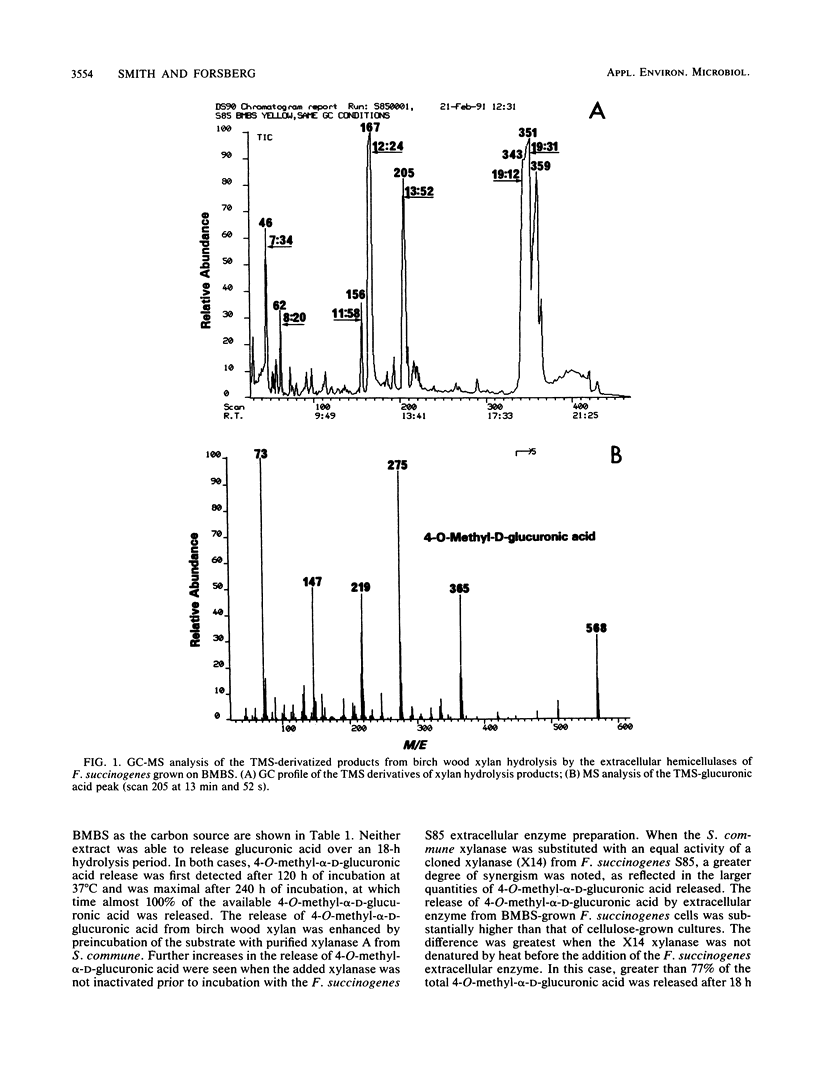
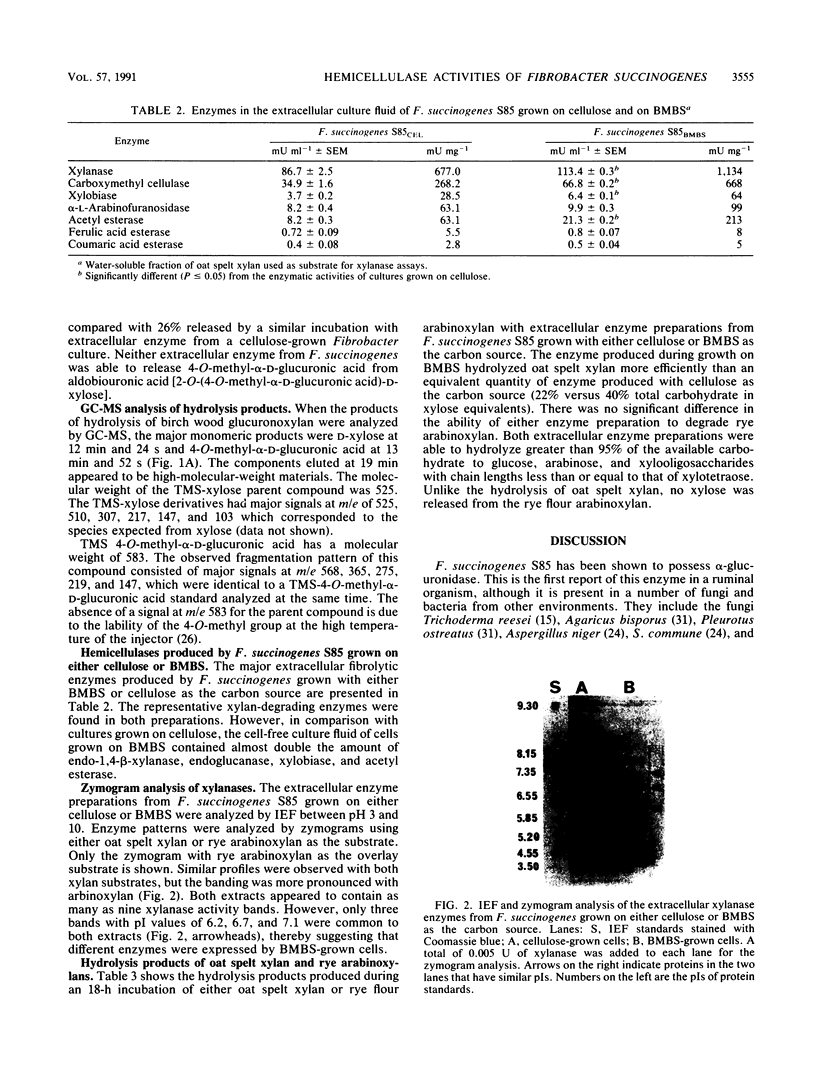
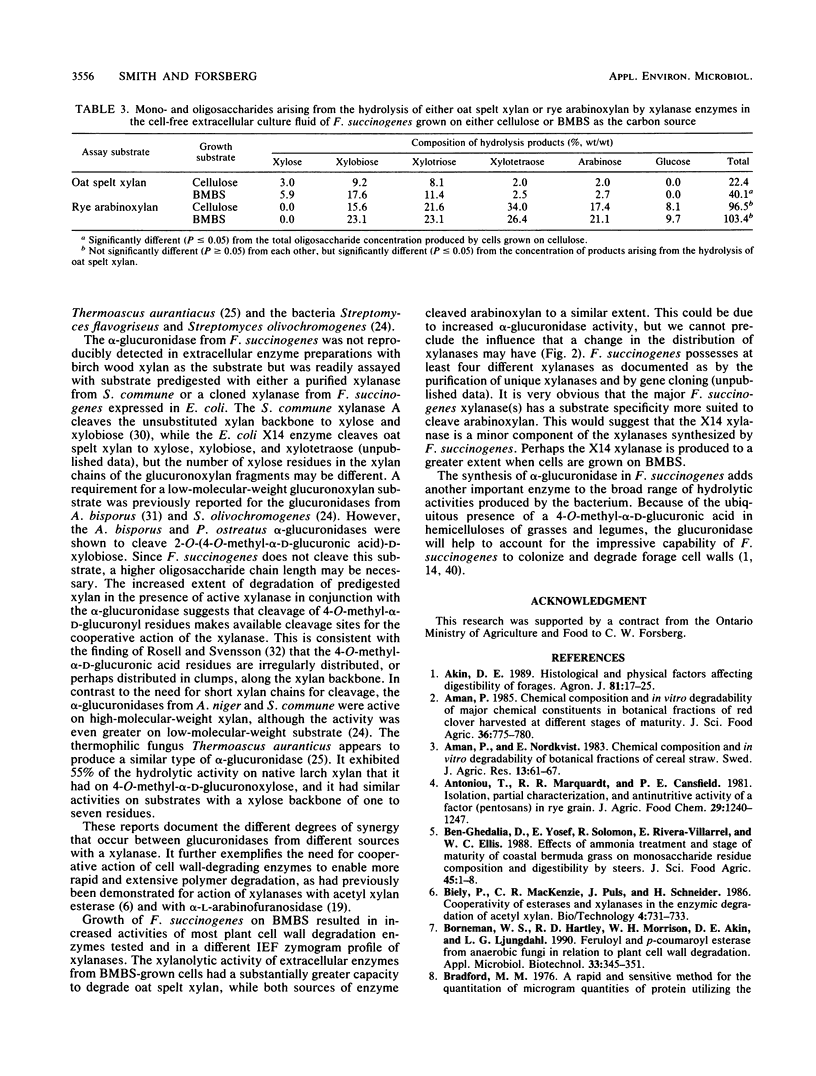
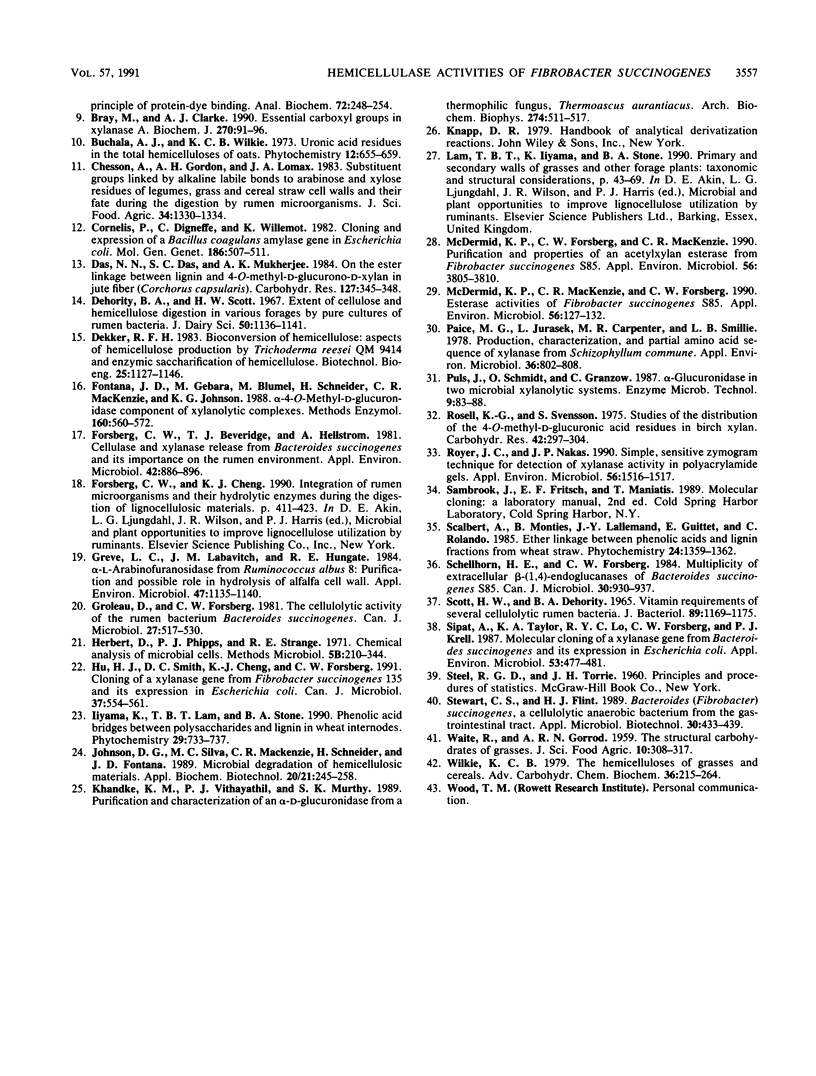
Images in this article
Selected References
These references are in PubMed. This may not be the complete list of references from this article.
- Antoniou T., Marquardt R. R., Cansfield P. E. Isolation, partial characterization, and antinutritional activity of a factor (pentosans) in rye grain. J Agric Food Chem. 1981 Nov-Dec;29(6):1240–1247. doi: 10.1021/jf00108a035. [DOI] [PubMed] [Google Scholar]
- Bradford M. M. A rapid and sensitive method for the quantitation of microgram quantities of protein utilizing the principle of protein-dye binding. Anal Biochem. 1976 May 7;72:248–254. doi: 10.1006/abio.1976.9999. [DOI] [PubMed] [Google Scholar]
- Bray M. R., Clarke A. J. Essential carboxy groups in xylanase A. Biochem J. 1990 Aug 15;270(1):91–96. doi: 10.1042/bj2700091. [DOI] [PMC free article] [PubMed] [Google Scholar]
- Cornelis P., Digneffe C., Willemot K. Cloning and expression of a Bacillus coagulans amylase gene in Escherichia coli. Mol Gen Genet. 1982;186(4):507–511. doi: 10.1007/BF00337957. [DOI] [PubMed] [Google Scholar]
- Forsberg C. W., Beveridge T. J., Hellstrom A. Cellulase and Xylanase Release from Bacteroides succinogenes and Its Importance in the Rumen Environment. Appl Environ Microbiol. 1981 Nov;42(5):886–896. doi: 10.1128/aem.42.5.886-896.1981. [DOI] [PMC free article] [PubMed] [Google Scholar]
- Greve L. C., Labavitch J. M., Hungate R. E. alpha-L-arabinofuranosidase from Ruminococcus albus 8: purification and possible role in hydrolysis of alfalfa cell wall. Appl Environ Microbiol. 1984 May;47(5):1135–1140. doi: 10.1128/aem.47.5.1135-1140.1984. [DOI] [PMC free article] [PubMed] [Google Scholar]
- Groleau D., Forsberg C. W. Cellulolytic activity of the rumen bacterium Bacteroides succinogenes. Can J Microbiol. 1981 May;27(5):517–530. doi: 10.1139/m81-077. [DOI] [PubMed] [Google Scholar]
- Hu Y. J., Smith D. C., Cheng K. J., Foresberg C. W. Cloning of a xylanase gene from Fibrobacter succinogenes 135 and its expression in Escherichia coli. Can J Microbiol. 1991 Jul;37(7):554–561. doi: 10.1139/m91-093. [DOI] [PubMed] [Google Scholar]
- Khandke K. M., Vithayathil P. J., Murthy S. K. Purification and characterization of an alpha-D-glucuronidase from a thermophilic fungus, Thermoascus aurantiacus. Arch Biochem Biophys. 1989 Nov 1;274(2):511–517. doi: 10.1016/0003-9861(89)90464-5. [DOI] [PubMed] [Google Scholar]
- Makino M., Davidson W. F., Fredrickson T. N., Hartley J. W., Morse H. C., 3rd Effects of non-MHC loci on resistance to retrovirus-induced immunodeficiency in mice. Immunogenetics. 1991;33(5-6):345–351. doi: 10.1007/BF00216693. [DOI] [PubMed] [Google Scholar]
- McDermid K. P., Forsberg C. W., MacKenzie C. R. Purification and properties of an acetylxylan esterase from Fibrobacter succinogenes S85. Appl Environ Microbiol. 1990 Dec;56(12):3805–3810. doi: 10.1128/aem.56.12.3805-3810.1990. [DOI] [PMC free article] [PubMed] [Google Scholar]
- McDermid K. P., Mackenzie C. R., Forsberg C. W. Esterase Activities of Fibrobacter succinogenes subsp. succinogenes S85. Appl Environ Microbiol. 1990 Jan;56(1):127–132. doi: 10.1128/aem.56.1.127-132.1990. [DOI] [PMC free article] [PubMed] [Google Scholar]
- Paice M. G., Jurasek L., Carpenter M. R., Smillie L. B. Production, characterization, and partial amino acid sequence of xylanase A from Schizophyllum commune. Appl Environ Microbiol. 1978 Dec;36(6):802–808. doi: 10.1128/aem.36.6.802-808.1978. [DOI] [PMC free article] [PubMed] [Google Scholar]
- Royer J. C., Nakas J. P. Simple, sensitive zymogram technique for detection of xylanase activity in polyacrylamide gels. Appl Environ Microbiol. 1990 Jun;56(6):1516–1517. doi: 10.1128/aem.56.6.1516-1517.1990. [DOI] [PMC free article] [PubMed] [Google Scholar]
- SCOTT H. W., DEHORITY B. A. VITAMIN REQUIREMENTS OF SEVERAL CELLULOLYTIC RUMEN BACTERIA. J Bacteriol. 1965 May;89:1169–1175. doi: 10.1128/jb.89.5.1169-1175.1965. [DOI] [PMC free article] [PubMed] [Google Scholar]
- Sipat A., Taylor K. A., Lo R. Y., Forsberg C. W., Krell P. J. Molecular cloning of a xylanase gene from Bacteroides succinogenes and its expression in Escherichia coli. Appl Environ Microbiol. 1987 Mar;53(3):477–481. doi: 10.1128/aem.53.3.477-481.1987. [DOI] [PMC free article] [PubMed] [Google Scholar]



